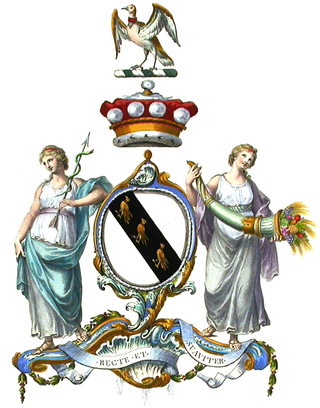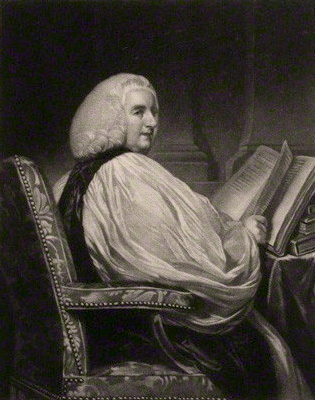
Earl of Cardigan is a title in the Peerage of England, currently held by the Marquesses of Ailesbury, and used as a courtesy title by the heir apparent to that Marquessate, currently Thomas Brudenell-Bruce, Earl of Cardigan, son of the 9th Marquess. The Brudenell family descends from Sir Robert Brudenell, Chief Justice of the Common Pleas from 1520 to 1530. His great-grandson, Sir Thomas Brudenell, was created a Baronet in the Baronetage of England, styled "of Deene in the County of Northampton", on 29 June 1611. On 26 February 1628, he was raised to the Peerage of England as Baron Brudenell, of Stanton Wyvill in the County of Leicester, and on 20 April 1661 he was further honoured when he was made Earl of Cardigan, also in the Peerage of England. On his death, the titles passed to his son, Robert, the 2nd Earl, and on the 2nd Earl's death to his grandson, George, the 3rd Earl, the 2nd Earl's only son, Francis, Lord Brudenell, having predeceased his father.

Baron Berners is a barony created by writ in the Peerage of England.

Earl of Egmont was a title in the Peerage of Ireland, created in 1733 for John Perceval, 1st Viscount Perceval. It became extinct with the death of the twelfth earl in 2011.

Earl of Rosslyn is a title in the Peerage of the United Kingdom. It was created in 1801 for Alexander Wedderburn, 1st Baron Loughborough, Lord Chancellor from 1793 to 1801, with special remainder to his nephew Sir James St Clair-Erskine, as Wedderburn had no surviving issue of his own. Wedderburn had already been created Baron Loughborough, of Loughborough in the County of Leicester, in the Peerage of Great Britain in 1780, with normal remainder to the heirs male of his body, and Baron Loughborough, of Loughborough in the County of Surrey, in the Peerage of Great Britain in 1795, with the same remainder as the earldom. The 1780 barony became extinct upon his death, but the 1795 barony and the earldom passed, by the special remainder, to his nephew, who thus became the second Earl of Rosslyn. The second Earl was a Lieutenant-General in the Army and also held political office as Lord Privy Seal and Lord President of the Council.

Earl of Chichester is a title that has been created three times, twice in the Peerage of England and once in the Peerage of the United Kingdom. The current title was created in the Peerage of the United Kingdom in 1801 for Thomas Pelham, 2nd Baron Pelham of Stanmer.

Earl Howe is a title that has been created twice in British history, for members of the Howe and Curzon-Howe family respectively. The first creation, in the Peerage of Great Britain, was in 1788 for Richard Howe, 4th Viscount Howe, but it became extinct upon his death in 1799. The second creation, in the Peerage of the United Kingdom, was in 1821 for Richard Curzon-Howe, 2nd Viscount Curzon, and it remains extant.
Earl of Bradford is a title that has been created twice, once in the Peerage of England and once in the Peerage of the United Kingdom. It was first created in 1694 for Francis Newport, 2nd Baron Newport. However, all the Newport titles became extinct on the death of the fourth Earl in 1762. The earldom was revived in 1815 for Orlando Bridgeman, 2nd Baron Bradford. The Bridgeman family had previously succeeded to the Newport estates. The title of the peerage refers to the ancient hundred of Bradford in Shropshire, and not, as might be assumed, to the city of Bradford, Yorkshire, or the town of Bradford-on-Avon in Wiltshire.

Viscount Scarsdale, of Scarsdale in Derbyshire, is a title in the Peerage of the United Kingdom. It was created in 1911 for the prominent Conservative politician and former Viceroy of India George Curzon, 1st Baron Curzon of Kedleston, who was created Earl Curzon of Kedleston at the same time and was later made Marquess Curzon of Kedleston.

Baron Bolton, of Bolton Castle in the County of York, is a title in the Peerage of Great Britain. It was created in 1797 for the Tory politician Thomas Orde-Powlett, who had previously served as Chief Secretary for Ireland. Born Thomas Orde, he was the husband of Jean Mary Browne-Powlett, illegitimate daughter of Charles Powlett, 5th Duke of Bolton, who had entailed the greater part of his extensive estates to her in default of male issue of his younger brother Harry Powlett, 6th Duke of Bolton.

Earl of Sunderland is a title that has been created twice in the Peerage of England. The first creation came in 1627 in favour of Emanuel Scrope, 11th Baron Scrope of Bolton. The earldom became extinct on his death in 1630 while the barony became either extinct or dormant. The second creation came in 1643 in favour of the Royalist soldier Henry Spencer, 3rd Baron Spencer of Wormleighton. The Spencer family descended from Sir John Spencer who acquired the Wormleighton estate in Warwickshire and the Althorp estate in Northamptonshire. His grandson Sir John Spencer was a Knight of the Shire for Northamptonshire. The latter's grandson Sir Robert Spencer represented Brackley in Parliament in the late 16th century. In 1603 Sir Robert was raised to the Peerage of England as Baron Spencer of Wormleighton. He was succeeded by his eldest surviving son, William, the second Baron. He had previously represented Northamptonshire in Parliament. His eldest son was the aforementioned third Baron. In July 1643 he was created Earl of Sunderland in the Peerage of England. Lord Sunderland was killed at the Battle of Newbury in September of the same year. He was succeeded by his two-year-old only son, Robert, the second Earl. He later gained great distinction as a statesman and notably served four times as Secretary of State for the Southern Department.

Marquess of Hastings was a title in the Peerage of the United Kingdom. It was created on 6 December 1816 for Francis Rawdon-Hastings, 2nd Earl of Moira.

Baron Carteret is a title that has been created twice in British history, once in the Peerage of England and once in the Peerage of Great Britain. The first creation came into the Peerage of England in 1681 when the fourteen-year-old Sir George Carteret, 2nd Baronet, was made Baron Carteret, of Hawnes in the County of Bedford. The peerage was originally proposed for his grandfather Sir George Carteret, 1st Baronet, a celebrated royalist statesman, but he died before he was granted the title and as his eldest son, Philip, predeceased him, it was eventually bestowed on his grandson, George, with remainder to the latter's brothers. The Baronetcy, of Metesches in the Island of Jersey, had been created for George Carteret in the Baronetage of England on 9 May 1645. Lord Carteret married Lady Grace Granville, daughter of John Granville, 1st Earl of Bath. In 1715 Lady Grace was raised to the Peerage of Great Britain in her own right as Viscountess Carteret and Countess Granville. Lord Carteret and Lady Granville were both succeeded by their son John Carteret, the second Baron and second Earl. The titles became extinct on the death of the latter's son Robert Carteret, the third Earl, in 1776.

Baron Rokeby, of Armagh in the County of Armagh, was a title in the Peerage of Ireland. It was created in 1777 for The Most Rev. Dr Richard Robinson, Church of Ireland Lord Primate of All Ireland and Lord Archbishop of Armagh, with remainder to his brothers and his father's second cousin Matthew Robinson and the heirs male of their bodies. In 1785 he also succeeded his elder brother as 3rd Baronet according to a special remainder. Lord Rokeby never married and was succeeded in the barony and baronetcy according to the special remainders in the letters patent by his third cousin Matthew Robinson-Morris, the second Baron and fourth Baronet. He was the son of Matthew Robinson, son of Thomas Robinson, son of Sir Leonard Robinson, brother of William Robinson, great-grandfather of the first Robinson Baronet and the first Baron Rokeby. The second Baron was an academic, politician and eccentric. Born Matthew Robinson, he assumed by Royal licence the additional surname of Morris in 1746 on succeeding to the Mount Morris Estate in Monks Horton, Kent through his mother. He never married and was succeeded by his nephew Morris Robinson, the third Baron. He was the elder son of Morris Robinson.

Viscount Maynard, of Easton Lodge in the County of Essex, was a title in the Peerage of Great Britain. It was created in 1766 for Charles Maynard, 6th Baron Maynard, Lord-Lieutenant of Suffolk. He was made Baron Maynard, of Much Easton in the County of Essex, at the same time, also in the Peerage of Great Britain. Both titles were created with special remainder, failing male issue of his own, to his kinsman Sir William Maynard, 4th Baronet. The 1st Viscount was unmarried and on his death in 1775 the baronetcy of Easton Parva, the Irish barony of Maynard created in 1620 and the English barony of Maynard created in 1628 became extinct. He was succeeded in the barony of 1766 and the viscountcy according to the special remainder by his kinsman Sir Charles Maynard, 5th Baronet, who became the 2nd Viscount. The latter was succeeded by his nephew, the 3rd Viscount, who served as Lord-Lieutenant of Essex. He had no surviving male issue and on his death in 1865 the baronetcy, barony and viscountcy became extinct. His granddaughter, Daisy Maynard, daughter of Colonel Charles Henry Maynard and future wife of Francis Greville, 5th Earl of Warwick, succeeded to most of the Maynard estates.

John Thynne Howe, 2nd Baron Chedworth, was an English peer and the eldest son of John Howe, 1st Baron Chedworth.

The Smith, later Bromley, later Pauncefote-Bromley, later Bromley-Wilson, later Bromley Baronetcy, of East Stoke in the County of Nottingham, is a title in the Baronetage of Great Britain. It was created on 31 October 1757 for the banker George Smith, High Sheriff of Nottinghamshire from 1757 to 1759. He was the eldest son of Abel Smith I (1686–1756) of Nottingham, the 2nd son of Thomas Smith I (1631–1699), the founder of Smith's Bank in Nottingham. His younger brothers included: Abel Smith II (1717–1788) and John Smith, ancestor of Julian Pauncefote, 1st Baron Pauncefote.

There have been four baronetcies created for members of the ancient House of Beaumont, all in the Baronetage of England. All four creations are extinct or dormant.

Scrope Howe, 1st Viscount Howe of Langar Hall, Nottinghamshire, was an English politician. He was the Member of Parliament (MP) for Nottinghamshire from 1673 to 1685 and January 1689 to 1691, and from 1710 to 1713.

Earl of Arran is a title in the Peerage of Ireland. It is not to be confused with the title Earl of Arran in the Peerage of Scotland. The two titles refer to different places: the Aran Islands in Ireland, and the Isle of Arran in Scotland. The Irish earldom is held by the Gore family. The Scottish earldom is a separate title, held as a subsidiary title of the Duke of Hamilton.

The Howe baronetcy, of Compton in the County of Gloucester, was created in the Baronetage of England on 22 September 1660 for John Howe, Member of Parliament for Gloucestershire in 1654–1655 and 1656–1658. His elder son Richard, the second baronet, was also an MP, as was his younger son John Grobham Howe. Sir Richard Grobham Howe, the third baronet, was MP for Tamworth, Cirencester and Wiltshire. Sir Emanuel Howe, 4th Baronet, became the 2nd Viscount Howe on the death of his father in 1713 and the baronetcy which he inherited in 1730 was merged with his viscountcy.















